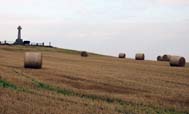Circles within circles:
Within the encircling bank and ditch, the great Outer Circle of Avebury once held 100 standing stones and was the largest stone circle in the British Isles. Arranged north and south inside it, stood two inner circles of large stones, with probably around 30 stones each. Within those in turn stood more stones: in the Southern Circle there were a rectangular or trapezoid setting of (chest-high) stones, of which a line now remains, and a tall pillar of sarsen (known as the obelisk), which was broken up in the 18th century and is now marked by a large pyramid-shaped concrete marker; in the Northern Circle a now-buried setting of the stones, possibly curving rows, and at its centre three huge stones, two of which still stand (known as the Cove).*
The cove:
Close to the road in the north-east quadrant of the henge are two of the tallest stones at Avebury. These form part of what has been know as the cove since the 18th century, named by the antiquary William Stukeley. Until 1713 (according to Stukeley) this setting had a third stone, standing as a pair to the tall, slim southern stone and forming, with the other two, a space rather like a stage without a roof.*
The Devil’s Chair:
This stone has a platform on it which is thought to be a seat. The stone is perfectly positioned to view the rising midwinter sun through the southern causeway entrance. The location of the chair also allows a view of the setting midwinter sun which can still be partly seen today.
In their book Avebury Sun, Moon and Earth, Maria Wheatley and Busty Taylor found that this stone had an active magnetic zone which when seated on the stone was near to the head and shoulders. The authors used a Spectrum Analyser and electromagnetic equipment to study the stones and found either three or five magnetic energy bands depending on the height of the stone. Their magnetic readings concluded that energy bands existed, but were unsure if the reading was from the stones themselves or due to their placement. The stone tapping into the magnetic energy of the earth.
*From National Trust 2008 guide book to Avebury revised 2011.












Wonder if they thought to themselves: ‘What we’re doing now will be discussed and argued over for millennia.’
I think they probably had entirely different thoughts on their mind.
Stones not typical of circles I’ve seen elsewhere. Do you know why, CP?
Wonder if I’m blocked here. Eh, James! Only your place?
I don’t know why the stones are not typical. Are you going to enlighten me?
Of course you are not blocked here, your thoughts are always welcome as is your friendship and kindness over the years
Ah, Avebury . . .
I still have the urge to go back again
Ir raises an issue of the ‘lot’ of the common chap in those days. One imagines that with no supermarkets or motor vehicles they had to spend every waking moment growing food and harvesting it, as well as making fires to cook it on and fetching water from a stream three miles away to cook it in.
Two possibilities then occur: a) they moved all those stones in their sleep, or b) they had to food bizzo down pat and really had far too much time on their hands.
Idle hands lead to politics and bludging. It is likely then that the local bigwigs had a version of work for the dole, organising and directing the shifting of stones to keep the disaffected off hedge corners.
I expect some men had the responsibility of placing/building the stones whilst others did the hunting. I expect the women did the cooking and gathering of food. Then there were all those ceremonies… It would be great to know what they actually did and how they so skillfully aligned the stones.
I’d love to see more of England’s stone circles. My hubby brought me back a book about them after visiting Scotland years back. I’ve seen Stonehenge of course, and one other one that I’ve now forgotten the name of (it was in 1988!) Somewhere in Cumbria maybe?
Hopefully you will get a chance one day. The one in Cumbria is called Castlerigg, it is one I have so far not been to.
Like the first pic especially, looks like some kind of agricultural fair!
The people in the foreground were congregating in front of the stone with the seat/platform. Shortly afterward a group of Germans started performing some sort of ritual in front of it. We left them to it and came back to that stone later when it was quieter.
The problem with Avebury (for me) is that it is reconstructed. I’d prefer it to be just as it was, personally, regardless of whether or not the reconstruction was accurate. A reconstructed Stonehenge would not appeal half as much as what is there now.
If it had been left as it was, most of the stones would not be visible due to the toppling and burying of them. It was excavations by Alexander Keiller in the 1930s that revealed the buried stones. Alexander re-erected these stones and also the ones that had fallen over. There are only 36 stones standing out of the many that would have formed the circles.
Parts of Stonehenge also fell and were re-erected in much the same way.
Agreed, but as I understand it so much reconstruction has been done on Avebury it just feels a bit fake to me. But as you know, I am a contrary creature. I still enjoyed visiting it, and it is still utterly fascinating.
I think perhaps a bit of research reading back to the people who wrote about it before the stones had fallen may help you to enjoy it more
Yes the whole concept of Avebury, Stonehenge and the other surrounding features are intriguing and fascinating.